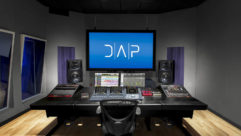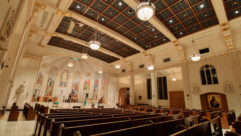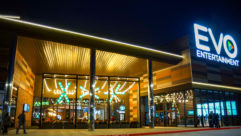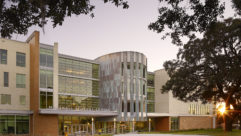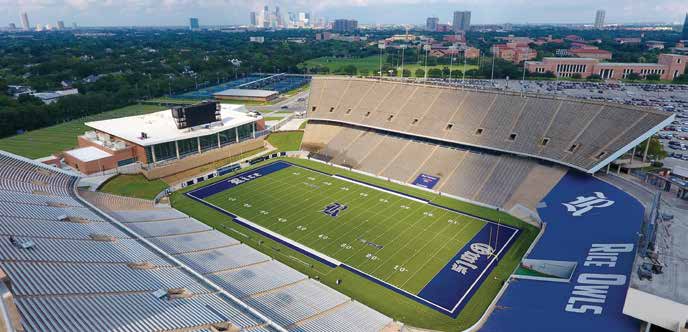

SVC: John, as the system designer, was there anything especially difficult? I would guess that the huge scale of this place might have been a challenge in itself.
John Miller: The design side was relatively straightforward with the owner’s parameters for excellent sound throughout. The design flaw we have in the facility is we have glass on three sides of that facility making primary and discrete reflections very prominent throughout the stadium if the sound system is not aligned properly. The centerpiece is the big end zone display and the sound wings that come off of that; were there other speakers put in around other places in the stadium?
John: The primary PA is installed in the left and right loudspeaker enclosure associated with the video scoreboard display. There are some minor fill-in loudspeakers below the display on a concourse level as well as some additional 70-volt loudspeakers in the press box area.
And Zach, I was thinking that crowd noise would be one of the big problems for this sound system. Was that the big thing on this or just the sheer scale?
Zach Richards: Well, that’s certainly right. The challenge in any application like this—where you’re talking about a significant distance to cover from the loudspeaker arrays—is to make sure we have the SPL to overcome crowd noise, but also the intelligibility at the far end of the field. We have to remember the system is shooting from one end zone across the entire field to the listening areas that are on either side. And with the university stadium there’s a significant amount of seating that goes up and the bowls on either side. So yeah, absolutely being able to get that intelligibility and coherency throughout the listening area is a key part of this and John did a tremendous job on the design. And certainly we coordinated closely with them throughout the process.

And where do you have the amps and the control equipment located? Is that in the press box area?
Zach: It’s a combination of the two. Of course we want the amplifiers to be located as close to the loudspeaker arrays as possible and so the design called for the amplifier rack to be housed in the same building that the video display is mounted on top of. It’s a new facility for them at Rice. So the amplifiers are there, and all of the control equipment, the mixing console and so on, is in the control room on the press booth level. We’re communicating via Q-SYS network. We’ve got Dante going into Q-SYS and then via fiber down to the amplifier rack. And then at that point we’re converting to AES, which is driving the amplifiers there on the broadcast facility.
They’ve got a Yamaha QL1 mixer for the stadium sound control. That seems to be a pretty simple one to operate. Do its features match the application fairly well? I would think that you don’t need a lot of sub-grouping or anything like that for this.
Zach: Well, that’s exactly right. It’s a great selection for this application. It is relatively easy to use and they do have operators that need to be able to just make some simple adjustments. However, there are a lot of powerful features within the QL1 that we’re utilizing as well – and I’ll let Mark speak to it a little bit. Mark, do you want to explain a little bit about how we’re doing those press feeds and additional audio distribution via Dante?
Mark May: Well, yes. The Dante comes out of the QL console and goes straight to Q-SYS and then from there we’re actually able to distribute it back to the broadcast feeds and the press booths as well.
How is the system powered? Do they have any kind of power backup?
Zach: There were discussions early on about what level of power backup was really needed. The logic was if there was a power failure if would most likely affect not only the audio system but the video system as well, and a lot of the network items associated with it. So there is not a backup battery system for the amplification portion of the system, however the network, all of the DSP, and the Q-SYS Cores are on a battery backup so that if there’s a short outage all that stuff stays maintained. When the power comes back on there’s not a long reboot cycle associated with any of that equipment. And you know certainly central Texas is prone to brown outs or just shorter fluctuations in power, so having the UPS on the more sensitive items to prevent the system from having to reboot is a smart thing. Another thing that we implemented in the design was a redundant Core system and Mark maybe you can just take a couple of minutes and explain how that works.
Mark: The Q-SYS system—the brains of it—are the Core 500is, two of them. With the way Q-SYS works, you basically put the first Core, the main Core, into a redundant mode and the next Core will follow suit on everything. This is an awesome feature to have. With this feature, we also wanted to make sure that we kept everything digital as well going from the Cores to the d&b amplifiers. So with each Core we’re sending out as AES line to each amplifier. To make sure that we didn’t have any issues with the AES and the clocking we took advantage of the d&b amplifiers with their SRC mode (sample rate converter) which is pretty neat–we can have both Cores feeding a d&b amplifier and not have any issues with clocking. If the first Core goes down, within about three to four seconds it will switch over and the sound continues to go on without any issues.
Zach: A small glitch, but hopefully no one notices that. And then it’s also configured with analog backup lines as well. So if for some reason we had a failure in the digital signal path, at least between the Q- SYS Cores and the amplifiers, then they could be switched to analog. We really try to do as much as possible to make the system as bullet proof as possible to make sure that every game is a success for them.
Well, it’s good to be able to fall back on the old three-wire if you need it.
Zach: Absolutely. Absolutely.
What are the system’s remote control capabilities? Do they have a web interface?
Zach: Mark, do you want to answer to that because you were just working on it earlier this week.
Mark: Sure. We do have what Q- SYS would call a UCI user interface where they can log on in the broadcast booth and be able to monitor and maintain the system there. There are a few different pages—one page allows them to turn the system on and off and be able to control some of the key volume parameters. A couple of the other pages are set for monitoring purposes. It’s actually set to talk between Q- SYS and the d&b amplification for the main arrays so if there are any issues it will flash on the CCI and let us know. The CCI is capable of going through Wi-Fi so they have a laptop in the press booth that they can hook up and monitor the system.
I think most of these stadiums have some sort of assisted listening system as well.
Zach: Yeah, that’s correct. There is an assisted listening system that’s part of the configuration. Pretty standard, with the exception of just needing to make sure that we had proper coverage. It’s quite a large stadium, so the transmitter resides in the control room and has a discrete feed, but then distributes that via a single FM transmitter to a number of belt packs and receivers as needed.
That could be interesting for someone who needed that in the middle of all that crowd noise going on, to be able to tell who the players are and so forth.
Zach: Well, absolutely. And it’s fairly commonplace these days. It’s something we’d like to see in every system design because the crowd noise can get quite disruptive.
I’ve never done PA at a big stadium but it’s got to be a little strange for the monitoring. You’ve got a big delay there. Do they just monitor it from the open air or do you have monitor speakers at the mixer?
Zach: They do have a monitor in the press booth, but when we were there for the first game, they actually opened up the window and preferred to listen to the direct sound coming from the main arrays at the video board. Even with the delay, no issues.
These games are all big television events. What happens when the broadcast trucks come in? Did this sound system include a big breakout panel somewhere for the broadcast trucks to connect to for the game coverage?
John: Yes. There is a broadcast pedestal on the northwest side of the stadium that all of the broadcast cabling terminates and then feeds into the production studio there in the new facility.
And I was wondering about this. How do you delineate between the mics? Are they all selected and run by the NCAA or some other ruling body or do they use your house sound system? How does that work?
John: The referee mics are specified by the design consultant or the owners—or referred to the owner for their preference. There is a criteria as far as the type of microphone that is utilized by the referees for each conference for Division 1 college football. But the manufacturer is typically left up to what is preferred by the university.
And Zach, how did you do the mic system receiving antennas? You’ve got to work at a great distance; that can be critical on the distance between the antennas and getting the signal to the receivers.
Zach: That’s a great question. One of the biggest challenges here is that we knew ahead of time that the area has a lot of RF activity. We were hearing from the client that they’ve had issues in the past. We really wanted to make sure that we picked the right frequency band and really found a good spot, so we actually ran about four days of frequency tests using Shure’s Axient system. Because, you know, we didn’t just want to take a snapshot of available frequencies. We wanted to know what the whole spectrum looked like over a four-day period. I’m glad we did, because we certainly saw significant bands that were available or appeared to be available. At one point, for example everything looked very available on this one particular band, but sure enough later on that evening when we were looking at our frequency analysis we saw a huge spike across that whole band. So really our biggest asset in setting up the wireless system was really knowing and understanding the RF environment around the university. Once we were able to identify clean, open bands, that’s of course where we put the wireless. And then we’re using an active directional antenna system that’s outdoor rated and really lets us make sure that we’ve got the coverage. But again I think that the primary thing there is just having open and available bandwidth where we’re not getting stepped on by other RF interference in the area.
The design called for most of the acoustic power to be right there in the huge display structure. What was involved in rigging the speaker arrays?
Zach: Certainly a challenge. I will say that we were using the d&b J-series line array boxes, which we were very familiar with and are also extremely easy to rig. And so that part made it easier for us. One of the things that also helped us out is that through the design process, in coordination with John and also the engineering team that designed and fabricated the steel structure, we were able to design a multipoint grid to suspend the d&b boxes. That was extremely helpful because we could get the array in place but still be able to make minor adjustments to the angles both horizontally and vertically. But I’m not going to lie. It was a huge challenge. The schedule worked out such that most of the array rigging was happening in July and August in Houston, which is extremely hot and our team just a fantastic job. Tim Kennard, our project manager, and our whole crew were out there in pretty much the hottest conditions possible getting those arrays hung—we’re really impressed and happy with how everything went there.
And John, since you designed this thing, did you find any common ground with other stadium projects?
John: Well, using a point source system for any facility is common due to the financial benefits of point source in lieu of a distributed system. The cost factor for going with a distributed system just eliminates it from most situations because of financial responsibility. Each facility is unique in its own way, but on the design side the acoustical properties of this facility were a little more cumbersome than projects we’ve done in the past. Zach, was there something you wanted to add to that?
Zach: Yeah, I was going to follow up on John’s comment earlier. The acoustics are certainly a challenge and I think the results of that system really turned out nicely. We ended up doing a lot of EQ work and a lot of things to really minimize some of the acoustic challenges in there and I think that was fantastic. The other thing that I’d like to mention, is this is the first stadium that has a d&b J-series system, so it’s really great to be able to hear that system in this kind of setting. Of course we’re familiar with the boxes in more of a touring/performance context. But John, would you agree? I think the boxes sound really good in there and the end result was really nice.
John: I am extremely pleased with the performance of the sound reinforcement system in that facility.
Now we’re going to talk about the huge new LED video display board from Daktronics that rises above the field. Dan Fjeldheim of Daktronics is going to give us the story behind the huge project. This is actually part of a much larger renovation for the stadium, isn’t it?
Dan Fjeldheim: Yeah, correct. About four or five years ago they had a vision to redo part of the stadium in regards to their training rooms, locker rooms, and sports medicine facilities. So the old video display was at the south end of the stadium and that’s kind of where they had pegged to put this new building up. As part of the construction of this new building they had to do some demolition on that south end of the stadium and that obviously made the existing scoreboard go away so they could have a footprint to build this new facility. They actually went the 2015 season without a video display as they did construction for this new facility down at the south end zone. But as part of that, they realized that they wanted to put the video display back up in that south end. So as part of the new building they built a structure to go up over the top of that building that would support the new video display.

One of the more interesting things about this is the LED technology that went into it.
Dan: In the middle, at 29 feet by 49 feet tall, will be their main primary video display. And that will be with our 13HD Technology. The 13HD is the benchmark standard in our industry when it comes to clarity and color depth and brightness. To give you an example, the 13HD has been installed in Jacksonville at that Jaguars Stadium. They are still the largest video displays in the world. The Cleveland Indians also debuted their 13HD products for the largest display in major league baseball. And on the collegiate level, Auburn University also has the largest video display with our 13HD products. So Rice didn’t cut any corners when it came to going with the best product that was available on the market today with our 13HD.
It appears that the new LED video display board is on top of a building. Are there special precautions or special techniques involved in putting it up there?
Dan: Because they were building the building below it, we had to work with the general contractor as far as the schedule of when we could install the displays. They did a majority of the building work first. Obviously they had to get the infrastructure up and the roof in place before we went up there and started hanging our displays. So the video display installation came towards the end of the actual project.
Does the direction that the display is facing require any kind of special consideration as to the sun angle or how it’s going to look at a certain time of day and time of the year when these games are likely to be played?
Dan: Yeah, it does. It really does. One of the things we did is bring a sample unit down to show them and faced it similar to the direction that this videoboard would be facing. We looked at it when it was in direct sunlight; one of the things they acknowledged is for some later afternoon/early evening games direct sunlight would be shining right on the video display. So we needed to make sure that we had the brightest product possible. So our 13HD product that we talked about a little bit earlier has very good brightness and can fight through that direct sunlight so that image doesn’t look washed out.
Did you use the existing cabling? It sounds to me as though you had to run new conduit and cabling and everything.
Dan: The conduit and cabling obviously run all the way up to the press box, but they also did some new locations where they were going to control their scoreboards and house their production equipment and all the Daktronics computers and software. So there was new cabling run. We utilized a bit of the existing conduit from the press box down to a certain location, but we kind of tied it off there and had to start new so it was a combination of new and old.

There’s always a challenge in having so many tradespeople working in close proximity. A major part of the planning is just in keeping people out of each other’s way.
Dan: We had weekly coordination meetings with the general contractor. A company called Anslow Bryant was the GC on the project. We needed to coordinate with them very closely.
How will you do the final test and who does the testing?
Dan: It kind of goes in a couple of different phases. The first phase is obviously to get the board physically in place. It comes in roughly 7 foot tall by 9 foot wide sections. So the video display itself of this size would be roughly about 20 sections of that display. And then from there, once those all get physically mounted and attached in place to the steel, then we come in with the electrical work and get the fiber optics and the signal cable connected. And then the last piece of it is to power, to get the electricity to it. So once those phases are all done we turn it on, get the computers wired up and then there is a testing phase just to make sure everything is working right and the electricity is flowing properly.
I guess that’s the “Wow” phase of it when you put the programming to work and see the moving images and the part that really gets the crowd’s attention.
Dan: Yeah. In the initial testing we’ll do some colors. We’ll go through a red, blue, green, white color wash with the LEDs – what we call burn in. Sometimes they take a few days to kind of get up to their full capacity and capability. So there is some initial color testing and then we start to program the board. These video displays can be one giant monitor or just like you’re watching your TV at home, but they can also be sectioned off or divvied up into different areas of the board where one area might show statistics, one area might show sponsors. One area may show the time and score. When that’s all ready to go then we actually send those images out to the board, see how it looks and tweak it a little bit to their liking. So there is kind of a physical testing with it and then there’s also the computer programming side of it as well.
How much does the entire display structure weigh?
Dan: It really depends on the size. A board like this at Rice weighs about 30,000-35,000 pounds. So we gave them those estimates early on in the process so the engineer that designed this structure could make sure he had enough structural steel there to support what we were going to put up.
One of the prime considerations on this is heat dissipation. You’ve got a lot of LEDs burning in there so how is heat handled within the display?
Dan: Each one of the modules – and when I say module I mean roughly a foot-by-foot section of the LED – has a fan on it. Along with that the top and the bottom of the display are open so that allows for some free-flowing air to be able to blow through that cabinet to trap any hot air that will be back there and let that flow through both the top and the bottom of the display. The Houston Astros have a similar product and a similar concept of the fans on the modules. Interesting to note that if you looked at an outdoor video display 8-10 years ago, in a warmer climate such as Houston you would need to have air conditioning. We still have some older displays with older technology that have actual air-conditioning units behind the boards to help keep them cool. Obviously those air conditioning units suck a lot of power and are not the funnest to maintain so it’s been a nice advantage that we’ve gotten able to get away from the air conditioning.
When you install one of these do you put the whole thing together at Daktronics and then take it apart and transport it to the site or is it first assembled onsite?
Dan: The display itself will come in different sections and depending on the overall size–like here we’re 29 feet tall by 49 foot wide–we’ll figure out what is the good fit for the amount of sections we can make. Our modules come in roughly foot-by-foot sections so we try and maximize the amount of sections so we don’t have to install as many as possible, but we also want to do a section that’s manageable and easy to put together, kind of like a puzzle. So for example at Rice it’s 20 sections: each of those 20 sections is built in the factory and each of those sections is tested individually in order to make sure it’s operating properly, that the LEDs are the right colors and those type of things. And then when they get to the site, although they’ve already been tested in the factory, once we get everything put together then the overall display is tested to make sure each of those sections have the same consistency of brightness and colors.
And of course you have to fasten all of the modules together and be able to replace any one of them. How is the wiring connected between the panels?
Dan: Each module has a ribbon cable that goes between it. So you’ve got the signal flowing left to right, but you also have the signal flowing right to left. The reason we do that is if for some reason we have a cable go bad or something would happen to one of the components, if you lose signal coming from one way, at least you have it coming from the other way. You may not see a visual outage on the display because we have that redundant signal path going back and forth.
What’s Daktronics got coming up on other big video display projects?
Dan: Right now there are quite a few NFL stadiums that we are finishing up. The Minnesota Vikings is a new stadium, a billion dollar stadium in Minneapolis. The Atlanta Falcons will be the largest LED display in the world when it opens this year. That’s kind of a cool application–envision a kind of a circular halo that is going to hang in the middle of their new stadium. We’ve also got some installations at the Miami Dolphins and the Tampa Bay Buccaneers. We’re kind of proud of the Buccaneers in the sense that they were one of the first NFL teams to purchase an LED video display from Daktronics and they bought it in 1997. So they’ve had that display in their stadium 18-19 years before they replaced it.



